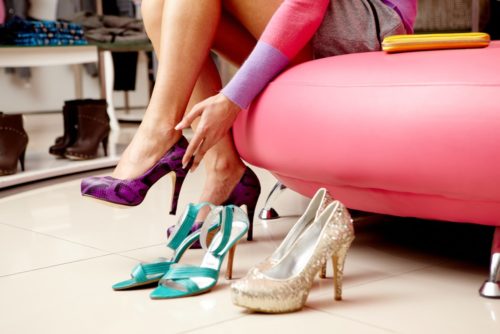
33+ Words to Talk About Clothes in Spanish
From buying a new camisa (shirt) to describing the chaqueta (jacket) you forgot on the bus, knowing how to describe clothes is essential in any language.
Whether you’re talla pequeña (size small), talla mediana (size medium) or talla grande (size large), I’ll help you find what you need to put your best fashion foot forward.
In this post, I’ll go over 33+ essential words to talk about clothes in Spanish for your next shopping trip!
Contents
- Ladies First: Spanish Clothes Vocabulary For Women
- Spanish Clothes Vocabulary For Gentlemen
- Most Essential Clothes in Spanish
- Important Spanish Phrases For Clothes Shopping
Download: This blog post is available as a convenient and portable PDF that you can take anywhere. Click here to get a copy. (Download)
When you use these words, remember that Spanish nouns are paired with gender-specific articles. Nouns are words that indicate people, places or things—like items of clothing!
Appropriate articles are paired with the nouns that follow but if you need to ask for multiples of an item rather than just one, remember to change the noun from the singular to the plural.
Here’s the article “the” in all its Spanish forms:
masculine singular — el
masculine plural — los
feminine singular — la
feminine plural — las
Let’s dress for success with some clothes vocab!
Ladies First: Spanish Clothes Vocabulary For Women
| English | Spanish |
|---|---|
| Skirt | La falda |
| Sweater | El suéter |
| Blouse | La blusa |
| T-shirt | La camiseta |
| Bra | El sostén |
| Panties | Las bragas |
| Stockings/Tights | Las medias |
| High-heeled shoes | Los zapatos de tacón alto |
| Dress | El vestido |
| Purse | El bolso |
Spanish Clothes Vocabulary For Gentlemen
| English | Spanish |
|---|---|
| Dress shirt | La camisa de vestir |
| Suit | El traje |
| Necktie | La corbata |
| Jacket | La chaqueta |
| Jeans | Los pantalones vaqueros |
| Boxer shorts | Los calzoncillos de hombre |
Most Essential Clothes in Spanish
Some items of apparel are fairly unisex so there’s no need to differentiate between men or women’s clothing.
Whether you’re looking to find something in a street market or department store, use these go-to words to find exactly what you want!
| English | Spanish |
|---|---|
| Pants | Los pantalones |
| Shirt | La camisa |
| Shoes | Los zapatos |
| Shorts | Los pantalones cortos |
| Belt | El cinturón |
| Hat | El sombrero |
| Boots | Las botas |
| Sandals | Las sandalias |
| Flip-flops | Las chanclas / Las chancletas |
| Socks | Los calcetines |
| Eyeglasses | Las gafas / Los lentes / Los anteojos |
| Sunglasses | Las gafas de sol |
| Bathing suit | El traje de baño |
| Pajamas | El pijama |
| Bathrobe | La bata de baño |
| Raincoat | El impermeable |
| Gloves | Los guantes |
As is the case with English, there are also a variety of words for clothes in Spanish in different Spanish-speaking countries around the world.
For example, the word “eyeglasses” is commonly used in American English, however in British English “eyeglasses” are called “glasses.” In Castilian Spanish (from Spain), “eyeglasses” are most commonly referred to as gafas, while in Mexico they are called lentes. You may also hear the word anteojos used in some countries in Latin America, however, this term is quite old-fashioned and less common.
Another example is chanclas and chancletas, which both mean “flip-flops” in Spanish. The word chanclas is most commonly used in Mexico and Spain to refer to this type of shoe, while in Colombia you’ll likely hear chancletas.
These are minor changes, however, the best way to start learning these variations is by immersing yourself in the language with Spanish content like TV shows or movies so you can see how these terms are used by native speakers from different Spanish-speaking countries. Another resource you could try is FluentU, which teaches Spanish through videos.
FluentU takes authentic videos—like music videos, movie trailers, news and inspiring talks—and turns them into personalized language learning lessons.
You can try FluentU for free for 2 weeks. Check out the website or download the iOS app or Android app.
P.S. Click here to take advantage of our current sale! (Expires at the end of this month)

Using authentic Spanish content as part of your language studies will help you pick up these words and start incorporating them into your own Spanish vocabulary.
Important Spanish Phrases For Clothes Shopping
Clothes shopping can be a highlight of any trip!
In many Spanish-speaking countries, there are colorful, locally woven textiles to feel and fall in love with. That’s a bonus that powers up an ordinary shopping excursion!
If you’re wondering how to start the shopping spree, just say Necesito ropa nueva (I need new clothes).
Of course, if you’re looking for something in particular, choose from the list of Spanish clothes vocabulary in this post and ask for that particular item.
To get the perfect fit, remember these important terms:
| English | Spanish |
|---|---|
| I wear a size… | Uso una talla… |
| Size small | Talla pequeña |
| Size medium | Talla mediana |
| Size large | Talla grande |
| Size petite clothing | Tamaño de ropa pequeña |
| Do you have a smaller size? | ¿Tiene usted una talla más pequeña? |
| Smaller | Más pequeña |
| Do you have a bigger size? | ¿Tiene usted una talla más grande? |
| Bigger | Más grande |
Traveling with children? Or maybe you’re thinking of bringing a unique gift home with you for a sobrina o sobrino (niece or nephew)?
Ask for ropa de niños (children’s clothing) to find the perfect item!
Spanish-speaking countries are filled with so many amazing sights—and that goes for what’s on the clothing racks!
Browse the shops to find the perfect article of clothing to round out your wardrobe. If you can’t find what you want, ask for help! Shopping is the ideal way to chat to and learn from the locals.
¡Buena suerte! (Good luck!)
Download: This blog post is available as a convenient and portable PDF that you can take anywhere. Click here to get a copy. (Download)
And One More Thing…
If you've made it this far that means you probably enjoy learning Spanish with engaging material and will then love FluentU.
Other sites use scripted content. FluentU uses a natural approach that helps you ease into the Spanish language and culture over time. You’ll learn Spanish as it’s actually spoken by real people.
FluentU has a wide variety of videos, as you can see here:

FluentU brings native videos within reach with interactive transcripts. You can tap on any word to look it up instantly. Every definition has examples that have been written to help you understand how the word is used. If you see an interesting word you don’t know, you can add it to a vocab list.

Review a complete interactive transcript under the Dialogue tab, and find words and phrases listed under Vocab.

Learn all the vocabulary in any video with FluentU’s robust learning engine. Swipe left or right to see more examples of the word you’re on.

The best part is that FluentU keeps track of the vocabulary that you’re learning, and gives you extra practice with difficult words. It'll even remind you when it’s time to review what you’ve learned. Every learner has a truly personalized experience, even if they’re learning with the same video.
Start using the FluentU website on your computer or tablet or, better yet, download the FluentU app from the iTunes or Google Play store. Click here to take advantage of our current sale! (Expires at the end of this month.)









